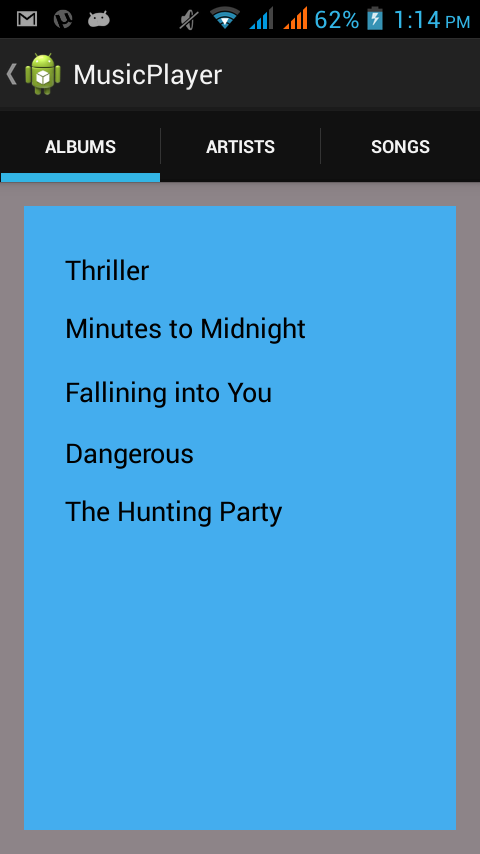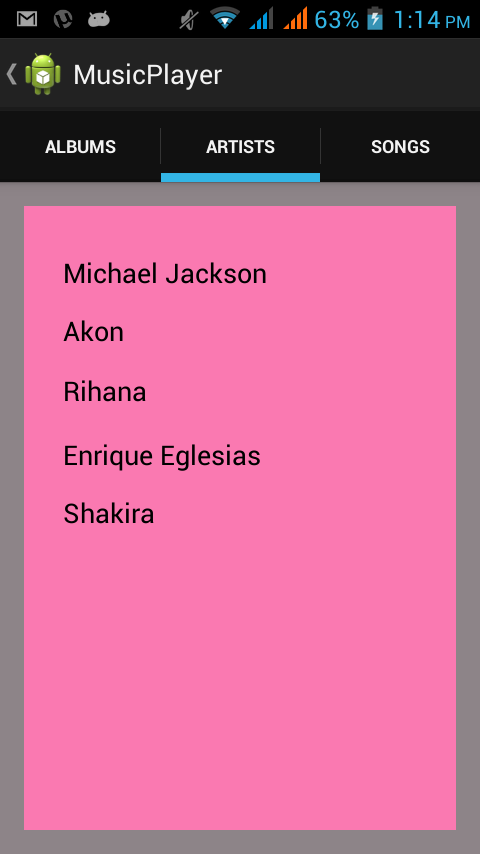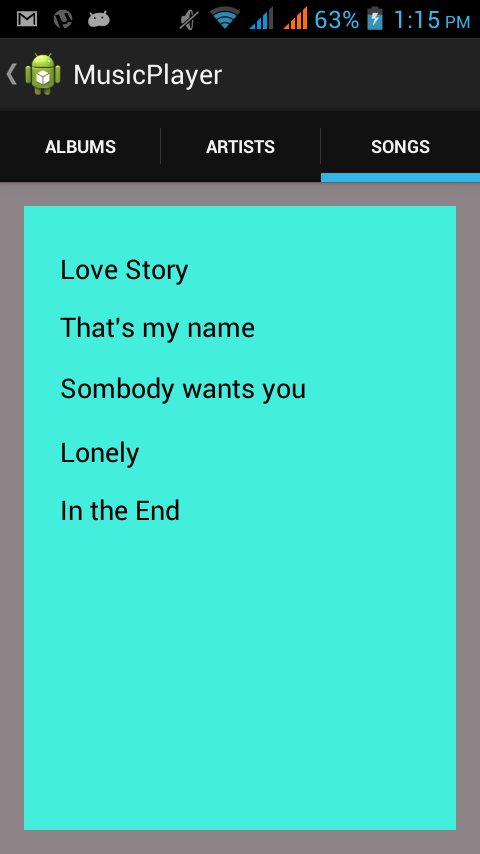Swipeable Tab Layout is very frequently used in most of the
android apps. It gives a user friendly UI as well instead of going next page
users can get several tabs options within one page by swipeable action. Here in my MusicPlayer example I have taken 3
tabs in main page fragment as Album, Atrists,Songs.
1. A parent fragment where all 3 child fragments will sit. (.xml file).
2. Three child fragments for three tabs layout (.xml file).
3. Main activity java file which will extend FragmentActivity. Here we will define the functionality and tabListener events.
4.An FragmentPagerAdapter which will set child fragments into parent.
5. Three separate fragments java file which will define the layout and views in child fragments.
Step-1: Create parent fragment xml file as
activity_main.xml. Add the viewPager as following:
<android.support.v4.view.ViewPager
xmlns:android="http://schemas.android.com/apk/res/android"
android:id="@+id/pager"
android:layout_width="match_parent"
android:layout_height="match_parent">
</android.support.v4.view.ViewPager>
Our activity_main.xml. will be like this:
Our activity_main.xml. will be like this:
activity_main.xml :
<RelativeLayout xmlns:android="http://schemas.android.com/apk/res/android"
xmlns:tools="http://schemas.android.com/tools"
android:layout_width="match_parent"
android:layout_height="match_parent"
android:paddingBottom="@dimen/activity_vertical_margin"
android:paddingLeft="@dimen/activity_horizontal_margin"
android:paddingRight="@dimen/activity_horizontal_margin"
android:paddingTop="@dimen/activity_vertical_margin"
tools:context=".MainActivity"
android:background="#8D8488" >
<!--Add ViewPager -->
<android.support.v4.view.ViewPager xmlns:android="http://schemas.android.com/apk/res/android"
android:id="@+id/pager"
android:layout_width="match_parent"
android:layout_height="match_parent">
</android.support.v4.view.ViewPager>
</RelativeLayout>
Step-2: Create 3 child xml file for 3 child fragments. Go to
layout folder and create 3 xml files.
In these tabs, design your layouts as you want to see in
each tabs. Here I have designed simply in RelativeLayout.
Mine looks like this.
album.xml :
<?xml version="1.0"
encoding="utf-8"?>
<RelativeLayout xmlns:android="http://schemas.android.com/apk/res/android"
android:layout_width="match_parent"
android:layout_height="match_parent"
android:background="#44ADEE">
<!--Add your views in layout what
you wanna design -->
<TextView
android:id="@+id/textView3"
android:layout_width="wrap_content"
android:layout_height="wrap_content"
android:layout_alignLeft="@+id/textView2"
android:layout_below="@+id/textView2"
android:layout_marginTop="18dp"
android:text="Fallining into You"
android:textAppearance="?android:attr/textAppearanceMedium"
/>
<TextView
android:id="@+id/textView2"
android:layout_width="wrap_content"
android:layout_height="wrap_content"
android:layout_alignLeft="@+id/textView1"
android:layout_below="@+id/textView1"
android:layout_marginTop="14dp"
android:text="Minutes to Midnight"
android:textAppearance="?android:attr/textAppearanceMedium"
/>
<TextView
android:id="@+id/textView4"
android:layout_width="wrap_content"
android:layout_height="wrap_content"
android:layout_alignLeft="@+id/textView3"
android:layout_below="@+id/textView3"
android:layout_marginTop="16dp"
android:text="Dangerous"
android:textAppearance="?android:attr/textAppearanceMedium"
/>
<TextView
android:id="@+id/textView5"
android:layout_width="wrap_content"
android:layout_height="wrap_content"
android:layout_alignLeft="@+id/textView4"
android:layout_below="@+id/textView4"
android:layout_marginTop="14dp"
android:text="The Hunting Party"
android:textAppearance="?android:attr/textAppearanceMedium"
/>
<TextView
android:id="@+id/textView1"
android:layout_width="wrap_content"
android:layout_height="wrap_content"
android:layout_alignParentLeft="true"
android:layout_alignParentTop="true"
android:layout_marginLeft="27dp"
android:layout_marginTop="30dp"
android:text="Thriller"
android:textAppearance="?android:attr/textAppearanceMedium"
/>
</RelativeLayout>
artists.xml :
<?xml version="1.0"
encoding="utf-8"?>
<RelativeLayout xmlns:android="http://schemas.android.com/apk/res/android"
android:layout_width="match_parent"
android:layout_height="match_parent"
android:background="#FA79B1" >
<!--Add your views in layout what
you wanna design -->
<TextView
android:id="@+id/textView1"
android:layout_width="wrap_content"
android:layout_height="wrap_content"
android:layout_alignParentLeft="true"
android:layout_alignParentTop="true"
android:layout_marginLeft="26dp"
android:layout_marginTop="32dp"
android:text="Michael Jackson"
android:textAppearance="?android:attr/textAppearanceMedium"
/>
<TextView
android:id="@+id/textView2"
android:layout_width="wrap_content"
android:layout_height="wrap_content"
android:layout_alignLeft="@+id/textView1"
android:layout_below="@+id/textView1"
android:layout_marginTop="14dp"
android:text="Akon"
android:textAppearance="?android:attr/textAppearanceMedium"
/>
<TextView
android:id="@+id/textView3"
android:layout_width="wrap_content"
android:layout_height="wrap_content"
android:layout_alignLeft="@+id/textView2"
android:layout_below="@+id/textView2"
android:layout_marginTop="15dp"
android:text="Rihana"
android:textAppearance="?android:attr/textAppearanceMedium"
/>
<TextView
android:id="@+id/textView5"
android:layout_width="wrap_content"
android:layout_height="wrap_content"
android:layout_alignLeft="@+id/textView4"
android:layout_below="@+id/textView4"
android:layout_marginTop="14dp"
android:text="Shakira"
android:textAppearance="?android:attr/textAppearanceMedium"
/>
<TextView
android:id="@+id/textView4"
android:layout_width="wrap_content"
android:layout_height="wrap_content"
android:layout_alignLeft="@+id/textView3"
android:layout_below="@+id/textView3"
android:layout_marginTop="18dp"
android:text="Enrique Eglesias"
android:textAppearance="?android:attr/textAppearanceMedium"
/>
</RelativeLayout>
songs.xml :
<?xml version="1.0"
encoding="utf-8"?>
<RelativeLayout xmlns:android="http://schemas.android.com/apk/res/android"
android:layout_width="match_parent"
android:layout_height="match_parent"
android:background="#44EEDD" >
<!--Add your views in layout what
you wanna design -->
<TextView
android:id="@+id/textView1"
android:layout_width="wrap_content"
android:layout_height="wrap_content"
android:layout_alignParentLeft="true"
android:layout_alignParentTop="true"
android:layout_marginLeft="24dp"
android:layout_marginTop="29dp"
android:text="Love Story"
android:textAppearance="?android:attr/textAppearanceMedium"
/>
<TextView
android:id="@+id/textView3"
android:layout_width="wrap_content"
android:layout_height="wrap_content"
android:layout_alignLeft="@+id/textView2"
android:layout_below="@+id/textView2"
android:layout_marginTop="16dp"
android:text="Sombody wants you"
android:textAppearance="?android:attr/textAppearanceMedium"
/>
<TextView
android:id="@+id/textView4"
android:layout_width="wrap_content"
android:layout_height="wrap_content"
android:layout_alignLeft="@+id/textView3"
android:layout_below="@+id/textView3"
android:layout_marginTop="18dp"
android:text="Lonely"
android:textAppearance="?android:attr/textAppearanceMedium"
/>
<TextView
android:id="@+id/textView5"
android:layout_width="wrap_content"
android:layout_height="wrap_content"
android:layout_alignLeft="@+id/textView4"
android:layout_below="@+id/textView4"
android:layout_marginTop="14dp"
android:text="In the End"
android:textAppearance="?android:attr/textAppearanceMedium"
/>
<TextView
android:id="@+id/textView2"
android:layout_width="wrap_content"
android:layout_height="wrap_content"
android:layout_alignLeft="@+id/textView1"
android:layout_below="@+id/textView1"
android:layout_marginTop="14dp"
android:text="That's my name"
android:textAppearance="?android:attr/textAppearanceMedium"
/>
</RelativeLayout>
Our designing part is over. Now let’s see our coding part.
Step-3: Go to src folder and create class for all three
child fragments .
Extend your ChildFrgment class by Fragment
AlbumFragment.java
package
com.allandroidprojects.musicplayer;
import android.os.Bundle;
import
android.support.v4.app.Fragment;
import
android.view.LayoutInflater;
import android.view.View;
import
android.view.ViewGroup;
import
android.widget.TextView;
public class AlbumFragment extends Fragment {
@Override
public View
onCreateView(LayoutInflater inflater, ViewGroup container,
Bundle
savedInstanceState) {
//Find your views
View rootView =
inflater.inflate(R.layout.album, container, false);
TextView
tvThriller=(TextView) rootView.findViewById(R.id.textView1);
TextView
tvMtoM=(TextView) rootView.findViewById(R.id.textView2);
return rootView;
}
}
Step-4: Create ArtistsFragment.java in src folder.
ArtistsFragment.java
package
com.allandroidprojects.musicplayer;
import android.os.Bundle;
import
android.support.v4.app.Fragment;
import
android.view.LayoutInflater;
import android.view.View;
import
android.view.ViewGroup;
import
android.widget.TextView;
public class ArtistsFragment extends Fragment {
public View
onCreateView(LayoutInflater inflater, ViewGroup container,
Bundle
savedInstanceState) {
//Find your views
View
rootView = inflater.inflate(R.layout.artists, container, false);
TextView
tvMichael=(TextView) rootView.findViewById(R.id.textView1);
TextView
tvAkon=(TextView) rootView.findViewById(R.id.textView2);
return rootView;
}
}
Step-5: Create SongsFragment.java in src folder.
SongsFragment.java
package
com.allandroidprojects.musicplayer;
import android.os.Bundle;
import
android.support.v4.app.Fragment;
import
android.view.LayoutInflater;
import android.view.View;
import
android.view.ViewGroup;
import
android.widget.TextView;
public class SongsFragment extends Fragment {
public View
onCreateView(LayoutInflater inflater, ViewGroup container,
Bundle
savedInstanceState) {
//Find your views
View
rootView = inflater.inflate(R.layout.songs, container, false);
TextView
tvLoveStory=(TextView) rootView.findViewById(R.id.textView1);
TextView
tvTmyName=(TextView) rootView.findViewById(R.id.textView2);
return rootView;
}
}
Your project may show errors , so simply clean project
errors will go off.
Step-6- Now Create TabsPagerAdapter.java to hold the child
fragments on parent.
Extend this class by FragmentPagerAdapter and add
unimplemented menthods.
TabsPagerAdapter.java
package
com.allandroidprojects.musicplayer;
import
android.support.v4.app.Fragment;
import
android.support.v4.app.FragmentManager;
import
android.support.v4.app.FragmentPagerAdapter;
public class TabsPagerAdapter extends
FragmentPagerAdapter{
public
TabsPagerAdapter(FragmentManager fm) {
super(fm);
// TODO Auto-generated
constructor stub
}
@Override
public Fragment getItem(int index) {
//Return child
fragments
switch (index) {
case 0:
// Albums fragment
activity
return new AlbumFragment();
case 1:
// Artists fragment
activity
return new ArtistsFragment();
case 2:
// Songs fragment
activity
return new SongsFragment();
}
return null;
}
@Override
public int getCount() {
// Return no of
tabs
return 3;
}
}
Step-7: Define the logic of tabs and swip actions in MainActivity.java
Extend this class by FragmentActivity implements
ActionBar.TabListener and add unimplemented methods.If file is giving errors then add this on top:
import android.app.ActionBar.TabListener;
Final Code:
MainActivity.java
package
com.allandroidprojects.musicplayer;
import android.os.Bundle;
import
android.app.ActionBar;
import
android.app.ActionBar.Tab;
import android.app.ActionBar.TabListener;
import android.app.Activity;
import
android.app.FragmentTransaction;
import
android.support.v4.app.FragmentActivity;
import
android.support.v4.view.ViewPager;
import android.view.Menu;
public class MainActivity extends FragmentActivity implements
ActionBar.TabListener {
//Declare the
components used
private ViewPager viewPager;
private TabsPagerAdapter mAdapter;
private ActionBar actionBar;
// Tab titles
private String[] tabs = { "Albums", "Artists", "songs" };
@Override
protected void onCreate(Bundle
savedInstanceState) {
super.onCreate(savedInstanceState);
setContentView(R.layout.activity_main);
// Initilize
components
viewPager=(ViewPager) findViewById(R.id.pager);
mAdapter=new
TabsPagerAdapter(getSupportFragmentManager());
actionBar=getActionBar();
viewPager.setAdapter(mAdapter);
actionBar.setDisplayHomeAsUpEnabled(true);
actionBar.setNavigationMode(ActionBar.NAVIGATION_MODE_TABS);
// Adding Tabs and clicking functionality
for(String tab_name:tabs){
actionBar.addTab(actionBar.newTab().setText(tab_name).setTabListener(this));
}
/**
* on swiping the viewpager make
respective tab selected
* */
viewPager.setOnPageChangeListener(new
ViewPager.OnPageChangeListener() {
@Override
public void onPageSelected(int position) {
// on changing the
page
// make respected tab selected
actionBar.setSelectedNavigationItem(position);
}
@Override
public void onPageScrolled(int arg0, float arg1, int arg2) {
// TODO Auto-generated
method stub
}
@Override
public void
onPageScrollStateChanged(int arg0) {
// TODO Auto-generated
method stub
}
});
}
@Override
public boolean
onCreateOptionsMenu(Menu menu) {
// Inflate the
menu; this adds items to the action bar if it is present.
getMenuInflater().inflate(R.menu.main, menu);
return true;
}
@Override
public void onTabReselected(Tab
arg0, FragmentTransaction arg1) {
// TODO Auto-generated
method stub
}
@Override
public void onTabSelected(Tab
tab, FragmentTransaction arg1) {
// on tab selected
//
show respected fragment view
viewPager.setCurrentItem(tab.getPosition());
}
@Override
public void onTabUnselected(Tab
arg0, FragmentTransaction arg1) {
// TODO Auto-generated
method stub
}
}
Step-7: Save the project, clean and run . You can see the tabs views by swiping as below screens.
Please feel free to comment for suggestions or doubts.
Thank You !!



